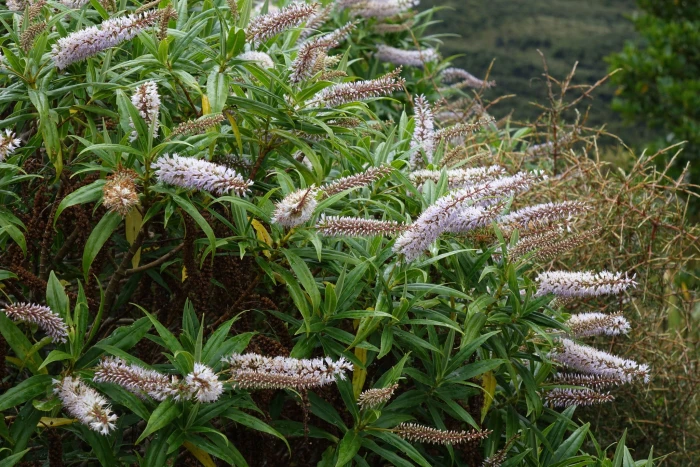Willow-Leaf Hebe
(Veronica salicifolia)
Willow-Leaf Hebe (Veronica salicifolia)
/
/

John Barkla
CC BY 4.0
Image By:
John Barkla
Recorded By:
Copyright:
CC BY 4.0
Copyright Notice:
Photo by: John Barkla | License Type: CC BY 4.0 | License URL: http://creativecommons.org/licenses/by/4.0/ | Rights Holder: John Barkla | Publisher: iNaturalist | Date Created: 2017-02-25T13:03:26-08:00 |



















































Estimated Native Range
Climate Requirements
| • Precipitation | 78" - 94" |
| • High Temp. | 64°F - 71°F |
| • Low Temp. | 26°F - 38°F |
Summary
Veronica salicifolia, commonly known as Willow-Leaf Hebe, is an evergreen shrub native to the open woodlands and forest margins of Southern Chile. It typically grows to a height of 8-13 feet and a width of 5-7 feet. The plant is characterized by its willow-like form with drooping branches and narrow, lance-shaped leaves. During the summer and fall, it produces spikes of white flowers that are notably fragrant and rich in nectar, attracting pollinators. The flowers add to the ornamental value of the shrub, making it an attractive addition to gardens.
Willow-Leaf Hebe is valued for its ease of maintenance, pleasant scent, and the abundant nectar its flowers produce. It is often used in urban plantings, as a border shrub, or for naturalizing in wetland-adjacent areas. Cultivation requires full sun to part shade, with a preference for well-drained soils. While it can tolerate wet conditions, it is not shade-tolerant and should be planted in a sheltered location. Once established, it exhibits drought tolerance and can withstand freezing temperatures, with reports of 50% leaf damage occurring at -0.6 °C. Potential problems include susceptibility to root rot in poorly drained soils and damage from heavy frost if not adequately sheltered.CC BY-SA 4.0
Willow-Leaf Hebe is valued for its ease of maintenance, pleasant scent, and the abundant nectar its flowers produce. It is often used in urban plantings, as a border shrub, or for naturalizing in wetland-adjacent areas. Cultivation requires full sun to part shade, with a preference for well-drained soils. While it can tolerate wet conditions, it is not shade-tolerant and should be planted in a sheltered location. Once established, it exhibits drought tolerance and can withstand freezing temperatures, with reports of 50% leaf damage occurring at -0.6 °C. Potential problems include susceptibility to root rot in poorly drained soils and damage from heavy frost if not adequately sheltered.CC BY-SA 4.0
Plant Description
- Plant Type: Shrub
- Height: 8-13 feet
- Width: 5-7 feet
- Growth Rate: Moderate
- Flower Color: White
- Flowering Season: Summer, Fall
- Leaf Retention: Evergreen
Growth Requirements
- Sun: Full Sun, Part Shade
- Water: Medium
- Drainage: Medium, Fast
Common Uses
Bank Stabilization, Bee Garden, Bird Garden, Butterfly Garden, Deer Resistant, Drought Tolerant, Hummingbird Garden, Low Maintenance, Rabbit Resistant, Salt Tolerant
Natural Habitat
Native to open woodlands and forest margins in Southern Chile
Other Names
Common Names: Koromiko
Scientific Names: Veronica salicifolia, Hebe salicifolia, Hebe fonkii, Veronica fonkii, Veronica lindleyana, Veronica salicifolia var. communis, Hebe salicifolia var. communis, Panoxis salicifolia
GBIF Accepted Name: Veronica salicifolia G.Forst.